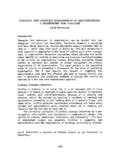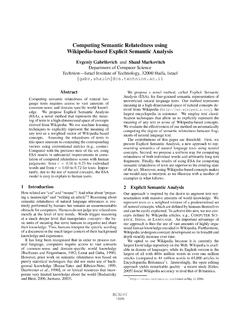Transcription of CONFLICT AND CONFLICT MANAGEMENT IN …
1 CONFLICT AND CONFLICT MANAGEMENT IN ORGANIZATIONS:A FRAMEWORK FOR ANALYSISJ acob BercovitchIntroductionResearch into behaviour in organizations can be divided into twocategories: normative and descriptive. Normative research is concernedwith how things should be, whereas descriptive research addresses itself towhat is rather than what could or should be. This dual perspective ismost apparent in approaches to the issues of CONFLICT and CONFLICT manage-ment in organizations. Normative approaches reflect attitudes and beliefswhich identify all conflicts as destructive and promote CONFLICT -eliminationas the formula for organizational success.
2 Descriptive approaches acceptconflict as inevitable and consider its proper MANAGEMENT the primaryresponsibility of all administrators. This paper pertains to the descriptivemode of inquiry in presenting a framework for the study of CONFLICT inorganizations. But it goes beyond this domain in suggesting thatadministrators must take the offensive and seek to manage CONFLICT , andalso in advocating that traditional methods of dealing with CONFLICT bereplaced by a new and more sophisticated : Towards a DefinitionConflict is endemic to all social life. It is an inevitable part of livingbecause it is related to situations of scarce resources, division of functions,power relations and role-differentiation.
3 Because of its ubiquity andpervasive nature, the concept has acquired a multitude of meanings andconnotations presenting us with nothing short of a semantic jungle. Likeother terms, CONFLICT generates considerable ambivalence and leaves manyscholars and administrators quite uncertain about (1) its meaning andrelevance and (2) how best to cope with normative conception of CONFLICT , strongly influenced by a pre-occupation with stability and equilibrium in organizational design, linksconflict to violence, destruction, inefficiency and This formof intellectual myopia was especially invidious in suggesting thatadministrators have the responsibility of avoiding, controlling or eliminat-Jacob Bercovitch is Lecturer in Political Science at the University Descriptive approaches challenge the whole basis andrationale of these assumptions.
4 They permit us to depart from an out-moded paradigm by suggesting that any social interaction in which theparties (however they may be structured or defined) compete for scarceresources or values has the potential for Using the term in abroad sense we suggest that CONFLICT refers to all kinds of antagonisticinteractions. More specifically, it can be defined as a situation in whichtwo or more parties have incompatible objectives and in which theirperceptions and behaviour are commensurate with that definition is purposely broad. It suggests that CONFLICT is a socialphenomemon that is found in personal, group or organizational inter-actions.
5 As such it comprises several dimensions. Fink5 distinguishesbetween (1) antagonistic-psychological relations and (2) antagonistic be-haviour, whereas Pondy6 observes that CONFLICT is made up of (1)antecedent conditions, (2) affective conditions, (3) cognitive conditionsand (4) behavioural conditions. We advance a conception of CONFLICT whichemphasizes its three, interrelated dimensions, namely: (1) CONFLICT situation(the basic incompatibility), (2) CONFLICT attitudes (range of psychologicalfactors) and (3) CONFLICT behaviour (set of related behaviour).7 CONFLICT refers to more than just overt behaviour.
6 Concentrating onlyupon its behavioural manifestation is an extremely limiting exercise. Thethree-dimensional conception of CONFLICT emphasizes the need to considerthe situation in which parties (individuals, groups or organizations) cometo possess incompatible goals, their structure of interaction and thenature of their goals. We have to consider emotional ( distrust) andcognitive ( stereotyping) orientations that accompany a conflictsituation as well as the range of action undertaken by any party in asituation of often feel that discussions of fundamental terms aremerely academic.
7 This is not always the case. Effective action and sensibleresponses depend upon clear thinking and systematic analysis . Under-standing must precede action. If administrators consider the problem ofconflict and understand that conflicts stem from ineradicable humanqualities and are related to situations of interdependence, scarce resourcesand perceptions of incompatibility,8 they might readily accept conflictand recognize its values provided, that is, they are properly aware of" CONFLICT MANAGEMENT " and the need to find a solution. Both conflictmanagement and a satisfactory solution are easier to attain when it isaccepted that what we normally call CONFLICT is a complex, multi-dimensional phenomenon.
8 It is not caused by "inadequate" structures, noris it undesirable. It is natural and inevitable and, properly managed, it isproductive, relevant and in OrganizationsOrganizations are living systems consisting of interacting units performinga task in a mutually dependent manner within a structure of scarce It seems commonplace to suggest that conflicts would be presentin such a setting. The parties in an organization may have a CONFLICT aboutthe distribution of resources, or they may have a more fundamental con-flict about the very structure of their organization and the basic nature oftheir Once the parties are in a situation of goal incom-patibility, their CONFLICT develops in a dynamic fashion, initiating valuableand much-needed constructive changes or leading to escalating strategiesand destructive there is nothing pre-determined about its course or development.
9 It seems erroneous to view CONFLICT from a negative perspective only asdestructive or dysfunctional. It is true that CONFLICT may be uncomfortable,it may even be a source of problems, but it is absolutely necessary ifchange is to occur, if organizations are to survive and adapt. Organiza-tional change and innovation does not just happen, it requires a stimulant is must accept the need to influence the developmentaldynamics of a CONFLICT , so that the parties' attitudes and actions will leadto better coordination and a more appropriate interdependence. Theymust not seek to stifle or eliminate organizational CONFLICT for that ishardly a realistic goal.
10 As Rico has noted, an organization devoid of con-flict ".. may indicate autocracy, uniformity, stagnation and mentalfixity."12 It would also be protecting only the vested interests of thestatus quo. Administrators must accept and indeed occasionally encourageconflict, because change and other desirable consequences are products The challenge administrators face is to utilize such conflictmanagement techniques that would ensure that as a CONFLICT passes from alatent to a manifest phase, it proceeds towards its potential and realizes itsconstructive Organizational ConflictThree distinct criteria define the role of an administrator in an organiza-tion.







![arXiv:1301.3781v3 [cs.CL] 7 Sep 2013](/cache/preview/4/d/5/0/4/3/4/0/thumb-4d504340120163c0bdf3f4678d8d217f.jpg)